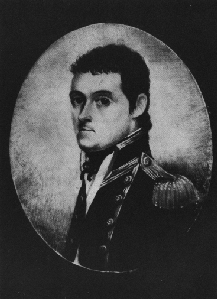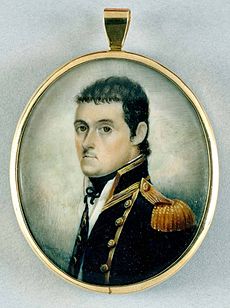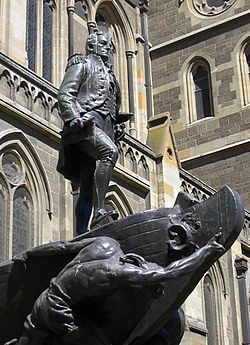Bass and Flinders were explorers.
They explored in a rowing boat called 'Tom Thumb'
They proved that Tasmania was an island, separated from the mainland of Australia.
George Bass (1771 - 1803)
George Bass
George Bass was born in England and became an apprentice surgeon while he was a teenager. At 18 he joined the British Royal Navy and in 1795 he sailed to New South Wales as the ship's doctor on board HMS Reliance.
Matthew Flinders
Wikipedia Commons
Matthew Flinders
(1774 -1814)
Matthew Flinders was born in England and joined the British Royal Navy at 15.
He was the Midshipman, or the master's mate, on the HMS Reliance where he met George Bass. Bass and Flinders shared an interest in exploring and after arriving in Sydney in 1795, they set out to explore the coast south of the settlement, sailing in a 2.5 metres long rowing boat called Tom Thumb.
Bass had brought this small boat from England. They explored Botany Bay and the Georges River. When they returned nine days later, their report to Governor Hunter led later to a settlement being made on the Georges River at Bankstown.
Bass and Flinders soon undertook a second voyage. This second voyage was in a boat, which had been built in Australia, also named Tom Thumb. But Tom Thumb ii - (Tom Thumb 2) was bigger than the original, about five metres long. It had a mast and a sail. This time the explorers set out to find a river, reported to be, south of Botany Bay. But their boat was blown off course. They returned having discovered and named, not the river, but Port Hacking and Lake Illawarra.
Look at images of Tom Thumb ii here
Bass Strait (marked blue) is named for George Bass
Because of voyages they had made separately, both Bass and Flinders were sure that a body of water separated Van Diemen's Land (now called Tasmania) and the Australian mainland. In 1798 they sailed along the northern coast of Van Dieman's Land. They rowed up the Tamar River to near where Launceston is today and later climbed to the top of Mount Wellington which overlooks Hobart. They proved that there was water between Australia and Van Dieman's Land and it was later named Bass Strait by Governor Hunter.
George Bass Disappears
In 1799 Bass resigned from the Royal Navy and sailed trading ships between the islands of the South Pacific. In 1803 he left Sydney headed for Chile in South America but the ship disappeared and George Bass was never seen again. The water separating Tasmanian from mainland Australia is named Bass Strait after George Bass.
Matthew Flinders after 1801
This statue is in Melbourne, Australia, near Flinders Street and is named for Matthew Flinders
Matthew Flinders returned to England in 1800 and published a book about his and Bass' explorations.
Flinders circumnavigated Australia
Then in 1801 Flinders was put in charge of an expedition to sail around and map the still unknown parts of the Australian coastline. He eventually circumnavigated (sailed all the way around) the Australian coast. It took almost three years to do it because of the poor condition of the ship, HMS Investigator, which needed regular repairs to stop it leaking.
A member of the crew onboard Investigator was Bungaree, an indigenous sailor, who is thought to be the first Australian to sail around the Australian coastline.
After returning to Sydney in 1803, Flinders sailed for England as a passenger on a ship called the Porpoise but the ship was wrecked on a coral reef off the Queensland coast. Flinders took control of the ship's lifeboat and sailed to Sydney to get help for the shipwrecked passengers.
Matthew Flinders arrested by the French
As its captain, Flinders sailed a small schooner, the Cumberland, towards England. When the ship started leaking, Flinders sailed to the island of Mauritius, a French colony. The French, who were at war with England, arrested Flinders as a spy and kept him in gaol on the island for six years. In 1810 Flinders arrived back in England. He was not in good health and only lived for another four years. He died in 1814, aged 40.
His body was discovered in London in 2019 while excavations were being made under a rail station for a new rail line. A lead breastplate on the coffin identified the grave as that of Flinders.
It’s a good idea to get information from more than one source!
Read more about Bass and Flinders
https://kids.kiddle.co/George_Bass





